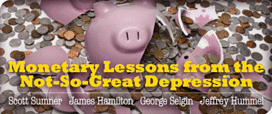In his first reply to the three of us, Scott Sumner asked: “Does anyone have any thoughts on my proposal to charge a negative interest rate on excess reserves as a way of reducing the hoarding of base money? Sweden recently adopted this proposal.” (I assume Scott meant “charge a positive interest rate,” which is the same as paying negative interest on excess reserves.) I’ll take the bait with a frank answer, even though I know next to nothing about how this has actually worked in Sweden. I think it is a dreadful idea, especially dangerous at the tail end of a crisis.
I have little doubt that, in the short run, the proposal would encourage banks to try to offload their reserves. Since in the aggregate they cannot reduce the monetary base, it would indeed encourage both further expansion of bank balance sheets through lending and conversion of reserves into currency held by the public. In other words, it would increase velocity. But let me first mention some technical issues. With reserve requirements virtually a dead letter, applying only to M1, charging interest on excess reserves (rather than total reserves) would in effect tax clearing balances that banks hold against their M2 and M3 liabilities. So it would unintentionally cause banks to encourage their customers to shift into M1 deposits, with consequences that I haven’t thought through. The tax would also comprise an indirect subsidy to money market mutual funds, which issue an M2 security but would not bear the tax. Doesn’t this raise the long-run specter of major financial disintermediation?
Charging interest on the banks’ deposits at the Fed poses no administrative problems, but banks also hold a lot of their reserves in the form of vault cash, especially for their ATMs, and this cash currently does not earn any interest. Unless you figure out a way to also charge interest on vault cash, banks would merely shift the composition of their reserves. On the other hand, charging interest on vault cash could eventually lead to the bright idea of imposing a similar tax on the public’s currency. Having the government directly tax everyone’s cash balances would, to my mind, be a nightmare, not the least because it gives an inept or avaricious central bank the ability, with a high enough tax, to set off a serious, velocity-induced inflation without actually increasing the money stock.
Whether the tax remains confined to banks or expanded to the general public, the effect on the yield of Treasury securities might be intriguing. Holding Treasuries would be a way of evading the tax. Would Treasuries entirely supplant reserves as the relevant component of the monetary base, and would the policy drive up prices of Treasuries to the point where they earned zero or even negative returns? Perhaps some fancy modeling from practitioners of the Fiscal Theory of the Price Level could answer these questions. One good thing is almost certain: charging interest on reserves would cripple the Fed’s discount window (and Term Auction Facility), because what bank would want to pay twice, borrowing at some specified discount rate reserves on which it has to pay additional interest anyway?
Even if the proposal is kept within reasonable limits, I have strong theoretical objections. I still haven’t gotten my head around the balance sheet implications of turning reserve liabilities into assets (or into liabilities that pay negative interest). But why would Scott, with his opposition to interest-rate targeting and to paying interest on reserves, want to actually increase the Fed’s ability to manipulate interest rates? This only undercuts his oft-repeated claim that mere monetary expansion (indeed, a mere expectation of such expansion) can completely offset and overwhelm any decline in velocity (i.e., any increase in the demand for money). The proposal simultaneously represents another step moving central banks away from their traditional role of controlling the money supply toward the central planning of the economy’s interest rates.
I’ve already pointed out that one way to think about paying interest on reserves is that it converts monetary into fiscal policy. Another way is that it combines two separate functions: monetary policy with federally subsidized financial intermediation. It thereby fuses the central bank’s traditional activity with that of such agencies as Fannie, Freddie, and the Federal Home Loan Bank System. Although I realize the Fed is already doing this through the wide variety of assets it now purchases, allowing it to convert bank reserves at will from a form of borrowing to a form of lending, and then back again, only exacerbates the potential chaos. I thought the disaster of Regulation Q and significant financial disintermediation during the 1970s had taught economist the lesson that central banks should not be allowed to play with interest-rate fire.
Call me an old-line Friedmanite, but if the economy must suffer under a central bank, it should be one that is circumscribed as much as possible. That means not giving the Fed additional powers, but stripping it of the powers to pay interest on reserves and to create subsidiary structured investment vehicles (like those with the label of Maiden Lane that made loans to Bear Stearns and AIG), as well as denying it the power to borrow money with its own securities, as Bernanke has advocated. Indeed, let’s go all the way with Friedman, and abolish the discount window, then eliminate all remaining reserve requirements (which the Fed is scheduled to gain the option to do in 2012), remove the Fed’s virtual monopoly on hand-to-hand currency, and while we are at it, prevent it from intervening in foreign exchange markets. Not one of these is essential for controlling the monetary base. Confine the Fed exclusively to open market operations using Treasury securities. All this strikes me as entirely consistent with Scott’s confidence in monetary policy’s efficacy.

